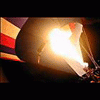Posted 22 October 2010 - 06:02 AM
Well, not claiming to be an Airbus expert by any means, but one reason could be that they may have been able to get the slats extended, but not the flaps. In big airplanes, slats tend to make more of a difference in approach speeds than flaps do. For example, in the 10:
Picking a gross weight of 300,000lbs (you'd obviously reduce to min practical in a case like this)
35/EXT Threshold speed (with slats, and 35 flaps--NORMAL): 131kts
0/EXT Threshold speed (with slats, but no flaps): 152kts
0/RET Threshold speed (no slats, no flaps): 188kts
Thats a difference of over 30 knots just for not having slats!
Then you compare it to
0/EXT Threshold speed (with slats, but no flaps): 152kts
22/RET Threshold speed (no slats, but 22* flaps): 177kts
That shows that with no flaps, but with slats, your threshold speed is more than 20 knots slower than if you had flaps but no slats.
Again, this is for a completely different airplane, but I would think the principle would be the same and MIGHT explain the "slower" approach speed. (And our numbers are fudged slightly from the normal DC-10 because of the boom) Something else they would have to take into account in a situation like this is the tire speed limitation. For us, it is 204kts (groundspeed), so anything in excess of that you'd be taking the chance of blowing out the tires, not from too much brake energy, but from speed alone. You'd definitely want to reduce gross weight as much as practical to get an approach speed below this.

























